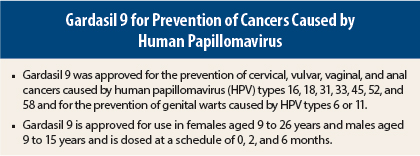In the Clinic provides overviews of novel oncology agents, addressing indications, mechanisms, administration recommendations, safety profiles, and other essential information needed for the appropriate clinical use of these drugs.
On December 10, 2014, Gardasil 9 (human papillomavirus 9-valent vaccine, recombinant) was approved for the prevention of cervical, vulvar, vaginal, and anal cancers caused by human papillomavirus (HPV) types 16, 18, 31, 33, 45, 52, and 58 and for the prevention of genital warts caused by HPV types 6 or 11.1,2 Compared with the previously approved quadrivalent Gardasil vaccine, the vaccine adds protection against HPV types 31, 33, 45, 52, and 58, which are estimated to cause 20% of cervical cancers. Gardasil 9 is approved for use in females aged 9 to 26 years and males aged 9 to 15 years. It is dosed at a schedule of 0, 2, and 6 months.
Vaccine Efficacy
Approval of Gardasil 9 was based in part on a double-blind trial in which 14,204 women aged 16 to 26 years with no screening for the presence of HPV infection were randomized to receive vaccination with Gardasil 9 (n = 7,099) or Gardasil (n = 7,105). The median follow-up was 40 months after the last vaccination. The primary endpoint was the composite of cervical, vulvar, and vaginal cancers, high-grade cervical/vulvar/vaginal disease (cervical intraepithelial neoplasia 2/3) or adenocarcinoma in situ, vulvar intraepithelial neoplasia 2/3, and vaginal intraepithelial neoplasia 2/3 due to HPV types 31, 33, 45, 52, or 58 in the per-protocol population.
The efficacy rate for the primary endpoint for Gardasil 9 was 96.7% (1 case in the Gardasil 9 group vs 30 cases in the Gardasil group). Efficacy rates for secondary endpoints were 98.6% against cervical intraepithelial neoplasia 1 (1 vs 69 cases), 96.3% against cervical intraepithelial neoplasia 2/3 or adenocarcinoma in situ (1 vs 27 cases), 93.8% against vulvar or vaginal disease (1 vs 16 cases), 96.2% against persistent HPV infection of at least 6 months (26 vs 642 cases), 96.1% against persistent HPV infection of at least 12 months (15 vs 375 cases), 92.6% against abnormal Pap tests (35 vs 462 cases), 96.9% against biopsy (7 vs 222 cases), and 87.5% against definitive therapy (4 vs 32 cases).
Efficacy of Gardasil 9 against the previously covered HPV types 6, 11, 16, and 18 in women aged 16 to 26 and in girls aged 9 to 15 years is inferred by the finding of noninferior anti-HPV antibody geometric mean titers compared with those found after Gardasil quadrivalent vaccine in immunogenicity studies. Efficacy of Gardasil 9 in girls and boys aged 9 to 15 years against all nine HPV types is inferred from immunogenicity studies showing noninferior geometric mean titers compared with those in the 16- to 26-year-old women after Gardasil 9.
In a study of immunogenicity in 921 girls and women aged 12 to 26 years who had previously been vaccinated with Gardasil, administration of Gardasil 9 starting at 12 to 36 months after the last injection of Gardasil resulted in antibody seropositivity to all HPV types ranging from 98.3% to 100% by month 7. Anti-HPV 31, 33, 45, 52, and 58 geometric mean titers were 25% to 63% of those compared with vaccinees who had not previously received Gardasil; the clinical relevance of these differences is unknown. The efficacy of Gardasil 9 in preventing infection and disease related to HPV types 31, 33, 45, 52, and 58 in this setting has not been assessed.
Safety Profile
In all studies, the most common (≥ 10%) local and systemic adverse events were injection-site pain (89.9%), injection-site swelling (40.0%), injection-site erythema (34.0%), and headache (14.6%) in females aged 16 to 26 years; injection-site pain (89.3%), injection-site swelling (47.8%), injection-site erythema (34.1%), and headache (11.4%) in girls aged 9 to 15 years; and injection-site pain (71.5%), injection-site swelling (26.9%), and injection-site erythema (24.9%) in boys aged 9 to 15 years.
Conditions potentially indicative of a systemic autoimmune disorder were observed in 2.4% of 13,234 Gardasil 9 and 3.3% of 7,378 Gardasil recipients. These rates are similar to those reported with Gardasil, amorphous aluminum hydroxyphosphate sulfate control, or saline placebo in historic clinical trials.
Gardasil 9 carries warnings/precautions for syncope and allergic reactions. Syncope, sometimes resulting in falling with injury, has occurred in vaccine recipients. Thus, observation of patients for 15 minutes after administration is recommended. Syncope associated with tonic-clonic movements and other seizure-like activity has been observed. Tonic-clonic activity usually is transient and typically responds to restoring cerebral perfusion by maintaining a supine or Trendelenburg position. Appropriate medical treatment and supervision must be readily available in case of anaphylactic reactions following vaccine administration.
Gardasil 9 is contraindicated in patients with hypersensitivity, including severe allergic reactions, to yeast, which is a component of the vaccine, and in patients with hypersensitivity reaction after a previous dose of Gardasil 9 or Gardasil. ■
References
1. FDA News Release: FDA approves Gardasil 9 for prevention of certain cancers caused by five additional types of HPV. Available at http://www.fda.gov/NewsEvents/Newsroom/PressAnnouncements/ucm426485.htm. Accessed January 7, 2015.
2. Gardasil 9 (human papillomavirus 9-valent vaccine, recombinant) prescribing information, Merck & Co, Inc, 2014. Available at http://www.merck.com/product/usa/pi_circulars/g/gardasil_9/gardasil_9_pi.pdf. Accessed January 7, 2015.


